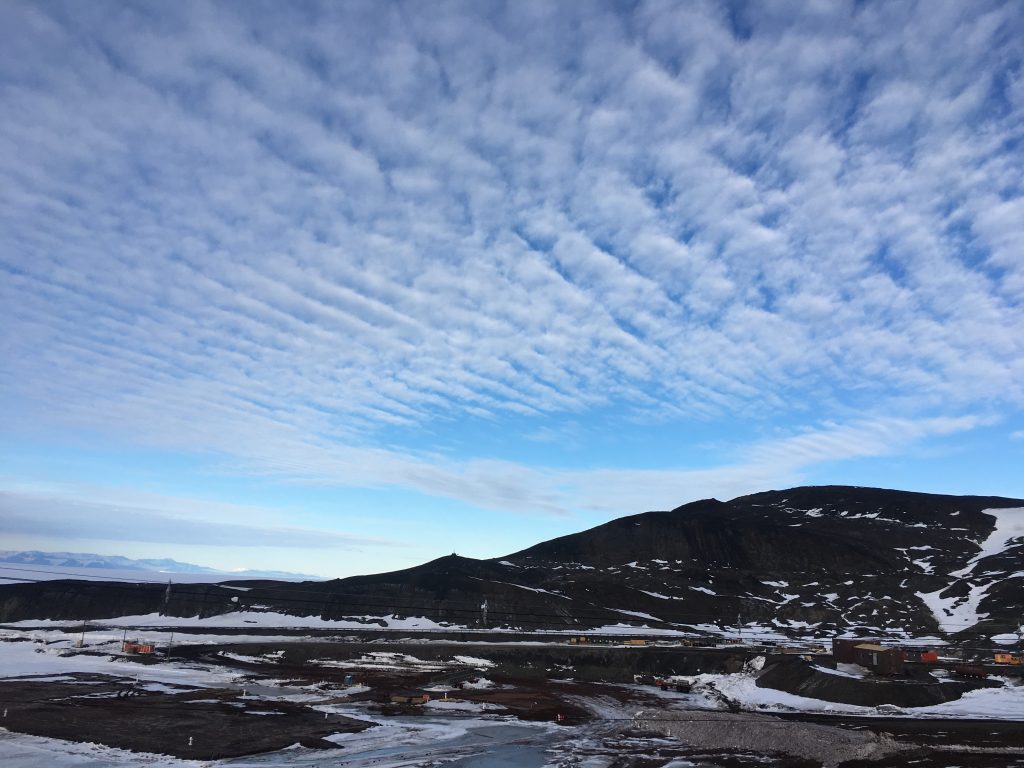And no, I’m not talking about gravitational waves like those created by the collisions of blackholes and measured by the incredible LIGO instrument (Fun fact: LIGO is basically a gigantic Michelson interferometer which, on a much smaller scale, our group uses to measure the wavelengths of our lasers).
I’m referring to atmospheric gravity waves which are generated when some force pushes air up or down from its equilibrium height. Even those who haven’t heard of atmospheric gravity waves have probably seen the characteristic, rippled cloud pattern that they generate.

Gravity waves are a key piece of the puzzle to the dynamics of the upper atmosphere because these waves can transfer energy and momentum from the lower atmosphere to extreme heights. This energy transfer is so significant that computer models of the upper atmosphere must incorporate some representation of these waves to be accurate.
As gravity waves travel through the atmosphere they perturb the pressure, density, and temperature of the air. Lidars are a fantastic tool for studying gravity waves because they can make high-resolution measurements of these perturbations. Our group has been making lidar observations of gravity waves in the upper atmosphere above McMurdo Station, Antarctica for 10+ years to study how these waves fit into the big picture of atmospheric dynamics and impact other atmospheric processes.

So how are gravity waves generated? To answer that question, we first have to understand a key concept called hydrostatic equilibrium. In an average sense, the Earth’s atmosphere can be considered to be in a state of hydrostatic equilibrium. That is, the gravitational force pulling air down towards Earth is balanced by the pressure gradient force that wants to suck the air back out into space. This balance of forces acts to keep a volume of air at a specific altitude where it is in equilibrium. This concept also explains why atmospheric density and pressure decrease exponentially with altitude. The gravitational force acting on the air decreases as you go higher up in the atmosphere, so if the pressure gradient force didn’t also decrease the air would be accelerated out into space. Therefore, atmospheric pressure, and consequently density, must decrease with altitude in order to keep these forces balanced.
However, consider what happens when some additional force acts on a volume of air to displace it from its equilibrium altitude. Any force or disruption that displaces air from its equilibrium height can result in the generation of gravity waves! A good example is when air is blown over a mountain. As an air parcels flows over a mountain it enters a region where the surrounding air is less dense and gravity acts to pull it back towards its equilibrium height. However, gravity pulls the air parcel down a little too far so that it is now surrounded by denser air, resulting in a buoyancy force which pushes the parcel back up. In fact, gravity waves are also called buoyancy waves because gravity and buoyancy are both restoring forces. Similar to a stretched or compressed spring that is then released, this oscillation continues and is what we call a gravity wave!

This kind of motion is responsible for the fantastic cap and lenticular clouds that form over mountain tops. The air parcel also cools as it is pushed over the obstruction and if the air is moist enough it can cool sufficiently to condense into clouds.


So not only are gravity waves responsible for these cool cloud phenomena, they have far-reaching impacts on atmospheric processes, hence the reason we go all the way to Antarctica to study them!

This is a wonderful introduction to gravity waves — one of the most intriguing phenomena in the Earth’s atmosphere and space system! The photos you posted also reminded me the great time our lidar team spent in Antarctica …
What an interesting read! I had no idea that those strange cliche formations were the result of such gravity waves. It’s interesting to think that these waves exist due to a relationship between atmospheric pressure and altitude.
Wow very interesting blog. Very cool to understand how these clouds form. I look forward to reading more of your blog posts.
Ian, great blog. It will be super useful for me as I feel like I’ve tried explaining the science of gravity wave study many times with varying levels of efficacy, now I’ll keep this like handy. Thanks for the clear concise overview.
Awesome summary Ian, I will be directing family here as a clear explanation of what we work on!
Fantastic blog! I have been trying to understand gravity waves by reading here and there but this was a great put together of an overview on gravity waves and how they affect Earth’s atmosphere. Now I can explain gravity waves easily to people who have never heard of them.
Very nice blog, Ian. I love the explanations and photos!
Excellent article. I liked the way you explain the difference between Gravitational Waves in Astronomy and Atmosphere.